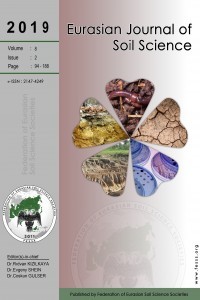
Eurasian Journal of Soil Science
Yazarlar: Amrakh İ. MAMEDOV
Konular:-
DOI:10.18393/ejss.24378
Anahtar Kelimeler:Water retention,Aggregate and structure stability,Water quality,Van Genuchtmodel
Özet: In arid and semi-arid zones with a short water resources studying the effects of water quality on soil water retention and structure is important for the development of effective soil and water conservation and management practices. Three water qualities (electrical conductivity, EC ~ 2, 100 and 500 μS cm -1 with a low SAR representing rain, canal-runoff and irrigation water respectively) and semi-arid loam and clay soils were tested to evaluate an effect of soil texture and water quality on water retention, and aggregate and structure stability using the high energy moisture characteristic (HEMC) method. The water retention curves obtained by the HEMC method were characterized by the modified van Genuchten (1980) model that provides (i) model parameters α and n, which represent the location (of the inflection point) and the steepness of the S-shaped water retention curve respectively, and (ii) a volume of drainable pores (VDP), which is an indicator for the quantity of water released by the tested sample over the range of suction studied, and modal suction (MS), which corresponds to the most frequent pore sizes, and soil structure index, SI =VDP/MS. Generally (i) treatments significantly affected the shape of the water retention curves (α and n) and (ii) contribution of soil type, water EC, and wetting rate and their interaction had considerable effect on the stability induces and model parameters. Most of changes due to the water quality and wetting condition were in the range of matric potential (ψ), 1.2-2.4; and 2.4-5.0 J kg -1 (pore size 125-250 μm and 60-125 μm). The VDP, SI and α increased, and MS and n decreased with the increase in clay content, water EC and the decrease in rate of aggregate wetting. The SI increased exponentially with the increase in VDP, and with the decrease in MS. Contribution of water EC on stability indices and model parameters was not linear and was soil dependent, and could be more valuable at medium water EC. Effect of wetting rate was more pronounced at low water EC. Results indicate that effectiveness of water EC in the field condition has no simple outcome on water retention and soil structure, and that its application should consider and be adjusted to soil properties and condition, such as soil texture, and moisture content and solution EC. Detailed contribution of treatments on structure induces and model parameters are discussed in the paper.